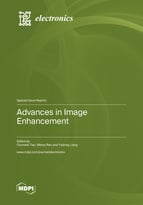Advances in Image Enhancement
A special issue of Electronics (ISSN 2079-9292). This special issue belongs to the section "Computer Science & Engineering".
Deadline for manuscript submissions: closed (1 March 2023) | Viewed by 43137
Special Issue Editors
Interests: deep learning; image restoration; video restoration; computer vision
Special Issues, Collections and Topics in MDPI journals
Interests: computer vision; image processing; deep learning; image deblurring; image dehazing
Special Issue Information
Dear Colleagues,
In the era of the Internet of Things, images have played important roles in human–computer interactions, and with the arrival of big data technology, people have higher requirements of image qualities, especially ones collected in dark light. This can be addressed through the development of camera hardware quality, i.e., the resolution and exposure time of cameras, which may require high computational costs. As an alternative, image enhancement techniques can exact salient features to improve the quality of captured images according to the differences of diverse features, although they suffer from some challenges, i.e., a low contrast, artifacts and overexposed, thus, making it decidedly necessary to determine how to use advanced image enhancement techniques.
Topics of interest include, but are not limited to, the following:
- Image enhancement
- Image restoration
- Machine learning and deep learning
Dr. Chunwei Tian
Dr. Wenqi Ren
Dr. Yudong Liang
Guest Editors
Manuscript Submission Information
Manuscripts should be submitted online at www.mdpi.com by registering and logging in to this website. Once you are registered, click here to go to the submission form. Manuscripts can be submitted until the deadline. All submissions that pass pre-check are peer-reviewed. Accepted papers will be published continuously in the journal (as soon as accepted) and will be listed together on the special issue website. Research articles, review articles as well as short communications are invited. For planned papers, a title and short abstract (about 100 words) can be sent to the Editorial Office for announcement on this website.
Submitted manuscripts should not have been published previously, nor be under consideration for publication elsewhere (except conference proceedings papers). All manuscripts are thoroughly refereed through a single-blind peer-review process. A guide for authors and other relevant information for submission of manuscripts is available on the Instructions for Authors page. Electronics is an international peer-reviewed open access semimonthly journal published by MDPI.
Please visit the Instructions for Authors page before submitting a manuscript. The Article Processing Charge (APC) for publication in this open access journal is 2400 CHF (Swiss Francs). Submitted papers should be well formatted and use good English. Authors may use MDPI's English editing service prior to publication or during author revisions.
Keywords
- image enhancement
- image restoration
- computer vision
- pattern recognition
- machine learning
- deep learning
- feature fusion







